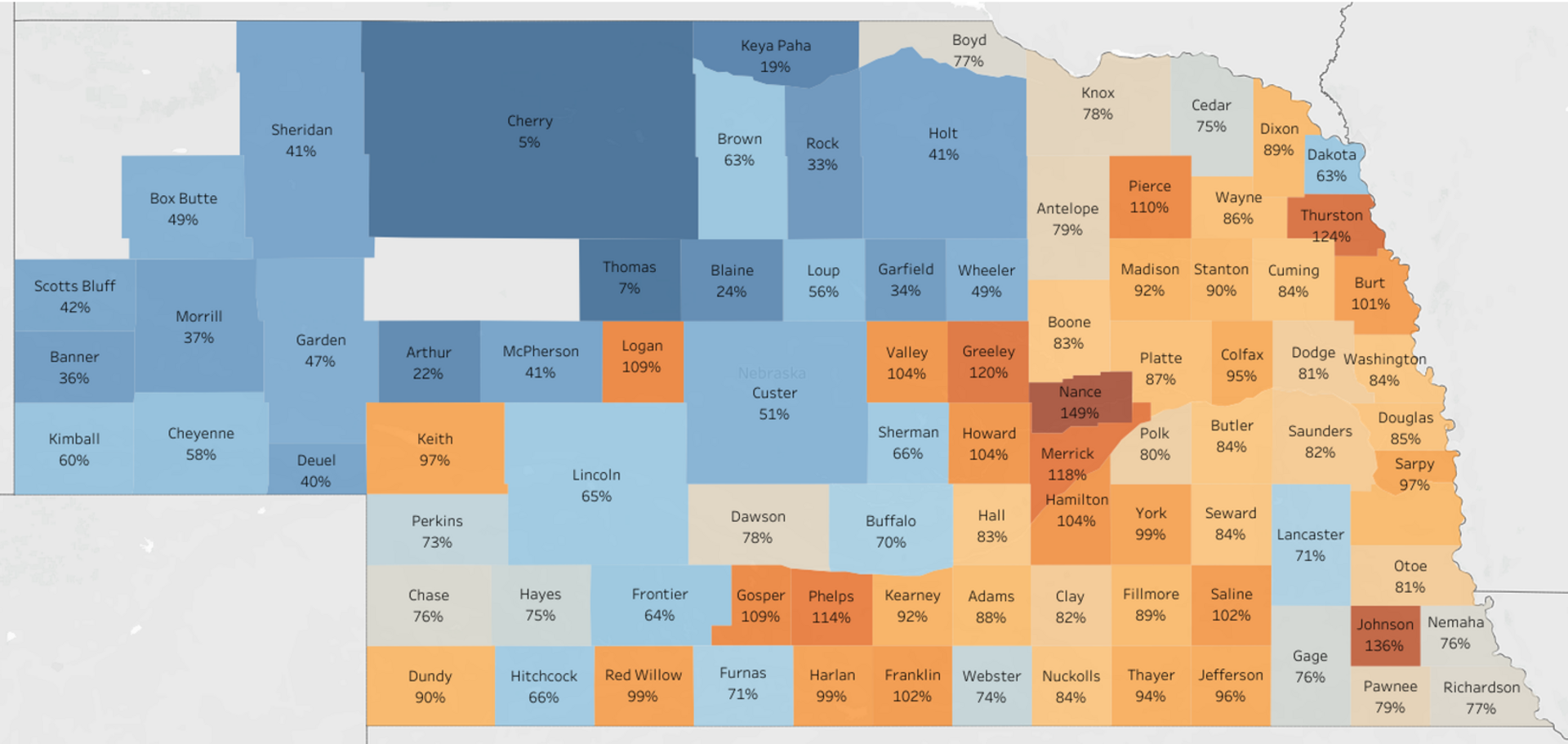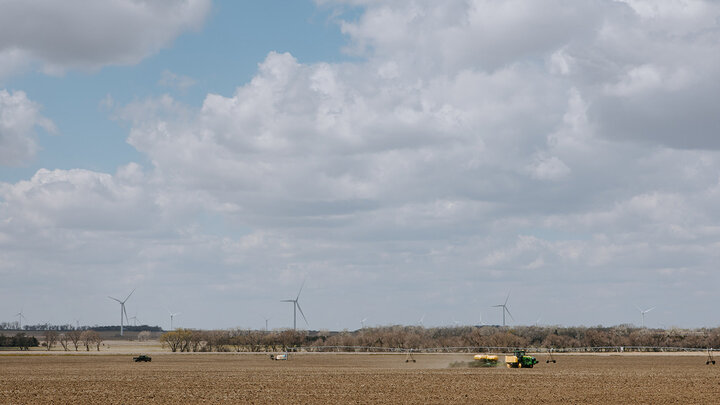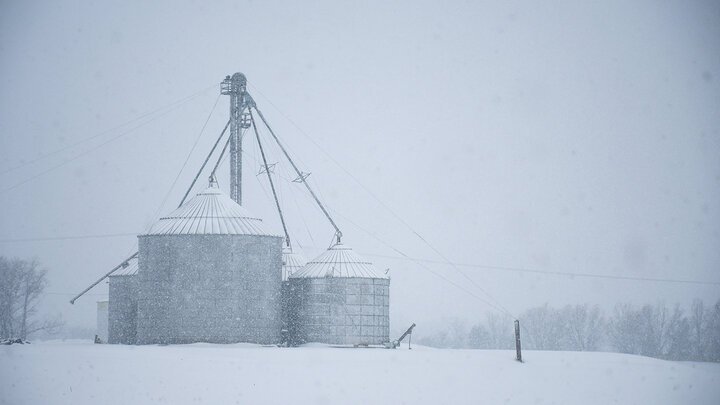This article was first published as part of the UNL Department of Agricultural Economics series "Cornhusker Economics" on July 23, 2025.
In the landscape of U.S. agriculture farm policy, two key terms are often misunderstood or overlooked: cropland acres and base acres. While cropland and base acres may sound similar, each has distinct meanings and implications, particularly in how farm-level payments are determined. Understanding the difference between cropland acres and base acres is critical for farmers and policymakers alike. This article will compare the 2024 Farm Bill Enrollment data to the 2022 Census of Agriculture and highlight the differences in cropland acres and base acres by county in Nebraska.
According to the USDA Census of Agriculture, cropland is defined as land that is used for growing crops, as well as land that could be used for crops but is lying fallow.
Base acres, by contrast, are a fixed number determined by historical planting data, typically tied to specific commodity programs managed by the USDA's Farm Service Agency (FSA). Base acres do not reflect what the farm is currently producing. Base acres are used to determine the farm payment. More base acres result in a larger farm payment. No base acres result in no payment.
How did base acres come about?
In 1995, the World Trade Organization (WTO) was established, setting the rules for global trade. In order to comply with WTO standards, subsidies provided to farmers must be “decoupled” from current prices and production in an effort to keep subsidies from distorting international trade. In the 2002 Farm Bill, base acres were established by referencing acreage planted between 1998 and 2001. Base acres were “assigned” to a covered commodity. Covered commodities are corn, soybeans, wheat, cotton (upland cotton), rice (both long and medium grain), grain sorghum, barley, oats, peanuts, canola, sunflower seed, flaxseed, safflower seed, sesame seed, dry peas, lentils, and chickpeas (small and large).
Farm owners were able to update the commodities associated with the farms' base acres during the 2014 Farm Bill enrollment to more accurately reflect the planting history from 2009 to 2012. However, in the 2014 update, farm owners were not able to update the number of base acres per farm.
Where is Nebraska today?
The inability to update the base acres has created disparities in the number of cropland acres reported by the Census of Agriculture and base acres used to provide program payments.
According to the 2022 Census of Agriculture, Nebraska boasts 21 million acres of cropland. However, 2024 Farm Bill enrollment data shows that the state has 15.89 million acres of base. In other words, approximately 75% of Nebraska’s cropland is supported by Farm Bill program payments.
Why the statewide shortfall? The reason for more cropland acres than base acres statewide is straightforward. Farm Bill program payments only support covered commodities. When base acres were established, base acres could not be assigned to acres planted with unsupported crops such as sugar beets, dry beans, and potatoes. This heavily impacted the ratio of cropland to base acres, especially in western Nebraska. Wheat-fallow rotations also impacted base acre allocation, as only half of the wheat ground during that time period would have been assigned as base acres. Again, heavily impacting western counties. Another possible cause of fewer base acre acres to cropland acres would be acres converted to cropland since 2001.
A look at the county level
The data becomes more interesting when brought down to the county level. Figure 1 shows the percentage of base acres to cropland acres per county.
Figure 1 Percentage of 2024 Base Acres to 2022 Cropland Acres by County

* Dawes-North Sioux, and South Sioux Counties are reported separately in the USDA Data. Combined, Dawes and Sioux County have 37% Base Acres. Grant and Hooker County have no Base Acres.
The map in Figure 1 shows that the difference at the county level in available base acres to cropland acres varies greatly between counties, ranging from 0% in Grant and Hooker Counties to 149% in Nance County. To view an interactive map online, visit: https://go.unl.edu/xzq2. This view provides another interesting question: how can a county have more base acres than cropland? Since 2001, cropland has been returned to pasture or native grasses, causing certain areas to have more base acres than cropland.
Unfortunately, we do not have access to farm-level data. Nevertheless, we do know that it is rare for a farm to have an equal number of cropland and base acres. At the farm level, the difference in base acres vs. planted acres makes a significant difference in the amount of support provided by Farm Bill Commodity Programs. Base acres must be taken into account to accurately identify the level of support from Farm Bill Commodity Programs. As it stands now, the Farm Bill Commodity Programs’ support decreases as you move from east to west.
Sources:
U.S. Department of Agriculture, Farm Service Agency. (2025, January 6). ARC/PLC program data, 2024 Enrolled Base Acres by Program by Commodity. https://www.fsa.usda.gov/resources/programs/arc-plc/program-data
U.S. Department of Agriculture, National Agricultural Statistics Service. (2024). 2022 Census of Agriculture (AC-22-A-51). https://www.nass.usda.gov/Publications/AgCensus/2022/




